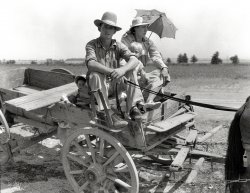
MAY CONTAIN NUTS

Search Shorpy
SHORPY ART

Framed or unframed, desk size to sofa size, printed by us in Arizona and Alabama since 2007. Explore now.
Join and Share
Ad-Free Shorpy
Shorpy is funded by you. Patreon contributors get an ad-free experience.
Learn more.

Recent comments
- Treescaping
- +112
- Rear View
- Way in the back --
- Button It Up
- And with an eye on the time ...
- Working in an enclosed ashtray
- Rear View Mirror?
- Tobacco cam
- Basic fact I learned only later in life
- Put a Lid on it!
- Pinstripes in the Tower
- Sound enhancement
- 3438 in '38
- Second Career
- Their days are numbered
- Only the Sensor
- Train control mechanism
- Rarest of the Rare?? & Classy 3400 Class
- Control Mechanism
- Those standpipes
- Wrenches
- International D-40 I believe
- Job prospects
- You had me at Train
- Land of the free
- Broad-Exchange Bldg
- Parking innovation
- The old block
- "Peck turned a sweet propeller"
Member Photos
The Shorpy
Printporium
Printporium
Search Shorpy
Search results -- 30 results per page
- Tattoo II: 1941
- ...
Hot Dog I'd love to see that light lit up at night.
LOVE the Hot Dog Sign That sign tickles me to no end! In the ... Posted by Dave - 06/24/2020 - 5:12pm -
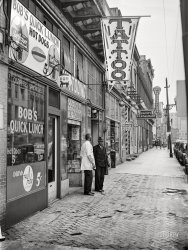
- Difficult Cases: 1941
- ... you wanted to receive Communion you went to confession the night before and got up for one of the early masses. In those days those ... Posted by Dave - 09/19/2019 - 4:13pm -
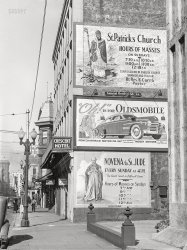
- Chinatown: 1900
- ... circa 1900. "Chinatown. The street of the gamblers at night." Nitrate transparency by Arnold Genthe. View full size.
Throwing ... Posted by Dave - 09/09/2011 - 12:57pm -
![Chinatown: 1900 San Francisco circa 1900. "Chinatown. The street of the gamblers at night." Nitrate transparency by Arnold Genthe. View full size.
Throwing Heaven and NineA dice game popular with Chinese immigrants around this time was called "throwing heaven and nine" or "chak tin kau." The game was played with two dice, with the different combinations divided into two suits. Players wager that the shooter will not throw the highest combinations. Rules can be found in the Archives of the University of Waterloo Museum of Games.
http://www.gamesmuseum.uwaterloo.ca
"Teneha, Timpson, Bobo & Blair!"
Goober Pea
Mirror imageJust letting you know, the image has been flipped. you can tell by looking at the Chinese characters in the current top left and bottom right corners.
[Thanks. I have flipped it around. What do they say? - Dave]
Ross AlleyGood photo. "The street of the gamblers" is formally known as Ross Alley, which runs from Sacramento Street to Washington Street, between Grant Avenue and Stockton Street. It is still a busy place, and it contains a wonderful fortune cookie factory.
Regards,
Joe Thompson
Translationliteral translation of the Chinese characters:
The top two characters:
call to wealth
The bottom four characters:
welcome the god of wealth
These are common decorations (lucky charms) for the entrance of a business.
Great site btw!
(The Gallery, San Francisco)](https://www.shorpy.com/files/images/7a55104u.thumbnail.jpg)
- The Milkmobile: 1943
- ... deck, and left it with your (rinsed, please!) empties at night.
I miss the Helms trucks more. Best chocolate and glazed donuts ever ... Posted by Dave - 03/06/2014 - 8:55am -
![The Milkmobile: 1943 June 1943. Bryn Mawr, Pa. Our second visit with Mrs. Helen Joyce, "one of the many women who now work for the Supplee-Wills-Jones Milk Co." Piloting a little Walker electric delivery van. Photo by Jack Delano. View full size.
Door to door serviceIn Woodlyn, another Philadelphia suburb, my first house had the kitchen in the front of the house with a little door outside below the kitchen window and another door inside. One would open the door on the inside and put in the empty bottles and the milkman would put in the fresh milk and whatever else you had ordered. You had to be especially quick on summer days or the milk could spoil. The little passage was not especially energy efficient, but the home was built in a different time
I vaguely remember in the early '60sthat my mother could actually order cottage cheese, cream, butter, chocolate milk and sour cream. Am I right?
FirstlyNeed to try and see if that lovely house behind her is still there, and, secondly, hasn't the USPS investigated the use of modern versions of these vehicles in major urban areas? Such devices might be just the ticket.
[The Postal Service is now it its third century of electric vehicle use. - Dave]
Thought they might have, wasn't sure. Thanks
My dairy could use some of theseWhen we moved out of the city in 1998, we were excited when we learned that our new community had a dairy that offered delivery, but we cancelled it after a few nights of their trucks loudly idling, roaring, and clanking outside house at 3 am, not to mention the huge spotlight trained on our bedroom window during the entire performance.
Milk is still delivered!Theoeva, we live just outside Washington, DC, in an old neighborhood that's now a historic district, and weekly milk deliveries are still part of the scene. The farm, which serves about 8,000 homes a week in this area, offers many locally made or grown products, including gourmet cheeses, meat, and even homemade dog treats. The homemade chocolate milk was my favorite.
We stopped using the service because we frankly couldn't consume the stuff fast enough. But the milk is provided in the old glass bottles in two different sizes. The firm provides an insulated metal bin that you put on the front porch in case you're away when it's delivery time.
At one time, they used an old-timey milk delivery truck (gas, not electric) but I don't know if they still use it.
Please rinse your emptiesYes, you could order all sorts of dairy products, as well as eggs, at least in Los Angeles you could. A fandeck of item cards was supplied, very similar to a paint sample deck -- you simply fanned out any items you wanted that day from the deck, and left it with your (rinsed, please!) empties at night.
I miss the Helms trucks more. Best chocolate and glazed donuts ever made!
The Philadelphia Main Line Never ChangesEntirely possible this very lady, in this exact truck, delivered milk to my house over in Haverford (the next postal district east on the Philadelphia Main Line) though that Haverford house would not become mine until 1968.
Sealtest milk (and cottage cheese, butter, etc)still exist. Our street looked exactly like this too, even down to the hedge fences. I suspect, if you knew which Bryn Mawr street this was, it would look exactly the same today.
Coming back soonThe first in electric mobility.
Although the main concern with the milk floats may have been not to annoy the neighbourhood early in the morning with one of those noisy IC engines idling away down the road.
Anyway, meet the 1943 Tesla.
(The Gallery, Cars, Trucks, Buses, Jack Delano)](https://www.shorpy.com/files/images/SHORPY_8d31084a.thumbnail.jpg)
- Orders Neatly Boxed: 1940
- ... packed in newspaper. I brought the leftovers to work that night, and joined co-workers in the cafeteria to eat. The Scotsmen a few tables ... Posted by Dave - 12/26/2012 - 9:39pm -
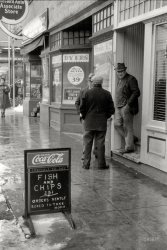
- The New Mathewson: 1910
- ... flag you would have thought Francis Scott Key spent the night on an English ship in the harbor.
remnants off to the right, the ... Posted by Dave - 08/02/2012 - 9:54pm -
![The New Mathewson: 1910 Narragansett Pier, Rhode Island, circa 1910. "Hotel (New) Mathewson." For many years the pre-eminent lodging in the "City of Hotels." View full size.
Oh, say, can you see?By the looks of that flag you would have thought Francis Scott Key spent the night on an English ship in the harbor.
remnantsoff to the right, the remains of the great McKim, Mead and White Narraganset Pier Casino, (The Towers,) which burned spectacularly in 1900
This is one a fire didn't getPerhaps the grandest hotel in the area when it was completed in 1896, the 500-room (New) Mathewson survived only 22 years. It was demolished in 1918, a victim of severely depressive effects of WWI on the tourism industry.
Shingle StyleWithout Googling it, I'd imagine it burned down, like so many hotels of the era. But if it didn't, I pity the guy who had to do the stripping ten years after some fool decided to paint it.
My HAT!OOOH GEEZ my hat!
[Indeed. - tterrace]
Coast Guard HouseI believe that house on the right with the anchor is now the Coast Guard House Restaurant. Had dinner there last summer. My first time in Narragansett.
The towers still exist.Spanning across the road:
View Larger Map
(The Gallery, DPC, Travel & Vacation)](https://www.shorpy.com/files/images/SHORPY_4a17166a.thumbnail.jpg)
- Hung Out to Dry: 1936
- ...
Rear Window? If this image had been shot at night, I would half expect to see the glow of Lars Thorwald's lit cigarette in ... Posted by Dave - 03/29/2013 - 12:35pm -
![Hung Out to Dry: 1936 December 1936. "New York. Scene from the Bronx tenement district from which many of the New Jersey homesteaders have come." There are a million stories in the Naked City, and a lot of them seem to involve laundry. Photo by Arthur Rothstein for the Resettlement Administration. View full size.
Fishing in the BronxI assume those are not fishing or flag poles on about every rooftop.
Does anyone know what they are for or their purpose?
Rear Window?If this image had been shot at night, I would half expect to see the glow of Lars Thorwald's lit cigarette in one of those darkened windows.
Radio AntennasMy aunt & grandmother lived in the LaReine apartments on Connecticut Ave, Washington, very near Chevy Chase Circle [built very late 1920s]. Each apartment had its own ++AM++ antenna on the roof with a cable to an outlet in the living room. There were frames on the roof with the antennas strung between them, as in this Shorpy photo.
Question from a Country BoyI understand that the larger (steel?) structures on the roof are for access by tenants, maintenance, etc. However the smaller units have doors that don't look walkable, and there seems to be an excess of them. My lifetime experience with roofs is just to shed rain and snow, so I become interested in the various uses on the city roofs.
Window BoxWhat is that in the top right window? And what's with the pillows stuffed in the window just to the left of that?
Re:Window BoxThe box is called a 'pie safe.' It's designed to let baked goods cool without them being swiped by pigeons, gulls, or boys.
If you look closely you can see perforations in it.
The pillows are probably being aired out. I wonder how often they had to be retrieved from the back yard.
As to the small doors on the boxes next to the chimneys I think those are trash chutes that lead to the ground or to a bin next to the furnace where they were incinerated.
Advantages of 4th floorI assume that the people on the fourth floor had dibs on the clothesline on the roof. In return for having to walk up all those flight of stairs, they never had to retrieve their bloomers from the lawn because one of the clothespins broke!
PolesWhat are all those poles for? Radio?
(The Gallery, Arthur Rothstein, NYC)](https://www.shorpy.com/files/images/SHORPY_8b28411a.thumbnail.jpg)
- King Dodo: 1910
- ... on Bourbon at Toulouse Street was destroyed by fire on the night of December 4, 1919. The Four Points Sheraton Hotel now occupies the ... Posted by Dave - 06/11/2013 - 1:33pm -
![King Dodo: 1910 1910. "French Opera House, New Orleans." Coming March 20: "King Dodo," a "phosphoronic comedy opera." 8x10 glass negative. View full size.
LogicalIf you're gonna have an 'Opera House', you're gonna need an 'Opera Saloon'.
Fire escapes?I count two fire escape landings, both sharing the same vertical ladder. Not very reassuring in the event of a fire during a packed house.
Let's hope the back of the opera house featured multiple fire escapes with wide, steel staircases instead of ladders. Right.
In need of paint?Can someone explain whether the upper story is in need of a paint job, or if the finish shown is some New Orleans distressed style of decorating?
While we're at it, is this interesting building still standing?
How oddNot a sign of life.
[There's at least one ghost. -tterrace]
Hear the Eminent Doctor Fizz!A recording of "Gems from King Dodo," recorded in 1912. http://www.loc.gov/jukebox/recordings/detail/id/2761/
Only 9 years to goOpening in 1859 and fast becoming the social hub of New Orleans, the French Opera House on Bourbon at Toulouse Street was destroyed by fire on the night of December 4, 1919. The Four Points Sheraton Hotel now occupies the site.
King DodoA synopsis of the plot of King Dodo, along with some other information.
(The Gallery, New Orleans)](https://www.shorpy.com/files/images/SHORPY_4a19855a.thumbnail.jpg)
- Gloomy Gippers: 1950
- ... seen that kind of locker room depression since... Last night with the Chicago Cubs.
Really? I'd be depressed too if I had to ... Posted by Dave - 10/26/2016 - 2:41pm -
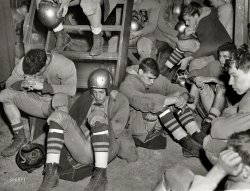
- Shirley Temple: 1928-2014
- ... Shirley told Mr. Roosevelt about losing a tooth last night, and he told her about Sistie and Buzzie losing their teeth. Shirley ... Posted by Dave - 02/11/2014 - 9:30am -
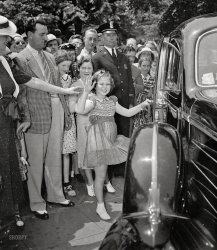
- Security Mutual Life: 1905
- ... whitish trapezoidal building, not shown above.
So last night, my wife and I watched the beginning of the 1991 movie "Liebestraum" ... Posted by Dave - 08/14/2012 - 4:59pm -

- The New World: 1936
- ... on the Coke sign (which I'm sure lit up and moved at night), all the pedestrians and 1930s cars! It just screams, New York!!
At ... Posted by Dave - 01/10/2016 - 1:04pm -
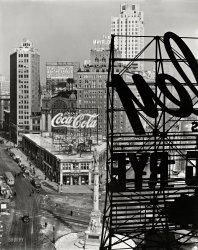
- Chronic Pianos: 1908
- ... words, an arc light that would light up a great area at night. Some still exist to this day in Austin Texas.
... Posted by Dave - 08/03/2021 - 2:00pm -
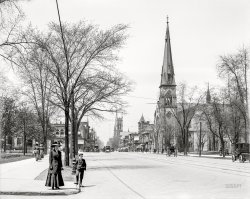
- City Sidewalks: 1940
- ... for WAC officers during WW2. It's still there. I spent the night there once.
(The Gallery, Cars, Trucks, Buses, John Vachon) ... Posted by Dave - 12/30/2007 - 10:47pm -
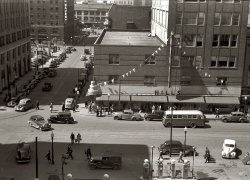
- Washington Pork: 1925
- ...
Market Basket Everyone has one! I went shopping last night for groceries, bringing along my reusable bags -- what I really like ... Posted by Dave - 08/05/2012 - 7:54pm -
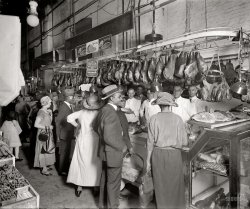
- Polishing Dept.: 1902
- ... place. Still I bet they coughed up a lot of brass dust at night.
Belts and wheels Amazing that those polishing wheels are ... Posted by Dave - 08/14/2012 - 12:53pm -
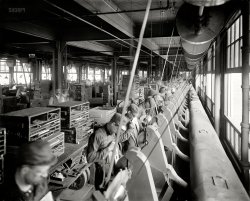
- Seal Beach: 1958
- ... and worked in Huntington Beach and would often grab a late night dinner at the Harbor House Restaurant in Sunset Beach. Yummy!
Those ... Posted by Mvsman - 08/31/2014 - 9:43pm -

- Avant-Garden: 1920
- ... with Ruth St. Denis. I just watched Pandora's Box last night.
(The Gallery, Dance, G.G. Bain) ... Posted by Dave - 08/25/2014 - 7:43pm -
![Avant-Garden: 1920 Denishawn dance company founder Ruth St. Denis and husband Ted Shawn with garden party guests (bridesmaids? caterers? vestal virgins?), among them the modern dance pioneers Louise Brooks and Martha Graham. View full size.
Before Bennifer, before Brangelina --There was Denishawn.
"Come my dear"Lets us show them how to Twerk.
Which one?One of my relatives (great-great-aunt? something along those lines) was a dancer for the Denishawn company and, in fact, changed her name to Florence O'Denishawn. I never knew her and am not sure, but she might be the one sitting on the far left.
DigitizedI notice that the dancers tend to have three fingers extended with the middle finger and thumb relaxed. I tried this hand gesture, and it does not feel natural. Perhaps this gesture separates the true modern dancers from the common folk shuffling around the dance floor?
Re: DigitizedThose are classical ballerina hands. The two main hand positions are called arrondi and allongé, and I believe they’re supposed to look graceful. To me, they look dementedly unnatural. I thought modern dance was supposed to do away with poses like that.
[Consider the alternatives. - Dave]
Martha GrahamI believe she is the young lady seated at the center of the photo, to the right of the other seated dancer. I saw her in the audience of one of her company's performances of "Appalachian Spring" in the late 1980s. It was unforgettable.
Ignorance and MisapprehensionThose are the two principles on which I base any comment on dance as art or entertainment, having been born awkward and dedicated myself early on to amplifying that.
Nevertheless, much modern dance seems to me to consist in the main of moving with grace and athleticism from one awkward pose to another. Dance is kinetic, obviously, which may be why the subjects of still photos like these invariably look odd, stuck in the pose rather than able to demonstrate how very lovely was their passage there.
Louise BrooksWhat a find! I had no idea Louise Brooks studied with Ruth St. Denis. I just watched Pandora's Box last night.
(The Gallery, Dance, G.G. Bain)](https://www.shorpy.com/files/images/SHORPY-35092u.thumbnail.jpg)
- Stripes and Solids: 1925
- ... They would set up on the hill over looking the town and at night light the crosses on fire and ride through town hooded up terrorizing ... miners and different ethinc peoples. Said it was a scary night.
(The Gallery, D.C., Natl Photo) ... Posted by Dave - 05/04/2016 - 12:25am -
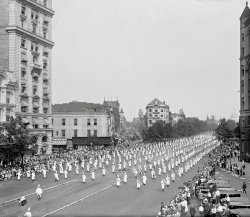
- Throw a Pair: 1924
- ... of his Cleveland Indians by sponsoring a free pantyhose night to lure the ladies to Municipal Stadium.
Ballsy display I wonder ... Posted by Dave - 02/20/2019 - 2:10pm -
![Throw a Pair: 1924 October 1, 1924. "Mogridge, Phillips & Martina buying baseball souvenirs." Washington players George Mogridge and Joe Martina with Nationals announcer E. Lawrence Phillips (2nd from right) at Griffith Stadium three days before the start of the World Series between the Nationals and Giants. View full size.
Okay, you asked for it!Men are always very proud of their balls, be they soccer balls, softballs, basketballs, golf balls or footballs. Do you know why policemen have bigger balls than firemen? Because they sell more tickets.
Ornamental HangersI wonder if the vendor thought this was as funny as I do.
One question...Can he twirl them?
This picture is begging for a caption contest.
Matrons at ballgames in 1924There would not have been many matrons at a baseball game in 1924 -- it was pretty much a man-only zone. (White men, to boot.) It wasn't until decades later than Bill Veeck broadened the appeal of his Cleveland Indians by sponsoring a free pantyhose night to lure the ladies to Municipal Stadium.
Ballsy displayI wonder how many matrons walked past this seemingly innocent yet ballsy display of souvenirs, straightened their backs indignantly and marched stiffly away? The idea tickles me.
Nationals?Wasn't the team's nickname the Senators, not the Nationals?
[In the real world the team was called the Nationals. Below: Nats win the World Series in October 1924. - Dave]
Augmentation Augmentation -- The early years.
CorrectionThat is not Under Secretary of State William Phillips in the photograph.
[Your correction is correct -- second from right is Nationals announcer E. Lawrence Phillips. - Dave]
(The Gallery, D.C., Natl Photo, Sports)](https://www.shorpy.com/files/images/12196u_0.thumbnail.jpg)
- On Walden Pond: 1937
- ... nearby. I loved going there to relax after working a night shift. I also love the sign stating you can get a Frappe since I moved to ... Posted by Dave - 06/14/2008 - 11:31am -
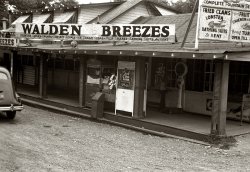
- Berkeley House: 1909
- ... a vain effort to save the historic Berkeley Hotel Saturday night.
The firemen braved temperatures which reached 26 below zero in a ... structure. The wind chill factor through much of the night was minus 40 or colder.
Twenty-two residents of the hotel were left ... Posted by Dave - 04/03/2019 - 3:09pm -
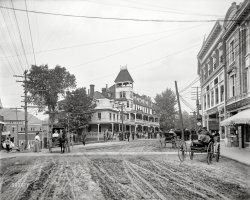
- Here's Lucy: 1908
- ... Yet for thirty-three years, for every hour of the day and night, they have been untiringly making the useless into the useful, magically ... Posted by Dave - 08/09/2012 - 2:42pm -
![Here's Lucy: 1908 Pittsburgh circa 1908. "Carnegie Steel Company, 'Lucy' furnace." 8x10 inch dry plate glass negative, Detroit Publishing Company. View full size.
Recycle 1908 styleThat is a very up-to-date string of coal cars in the background. All steel cars show Keystone Coal to be a very modern operation.
In the foreground is several stretches of disconnected narrow gauge plant track, with a string of cars and wheelsets nearby. These plantracks would change location quickly, as needed.
But what really interests me is that arch-roof former baggage car lettered American Bridge of NY. That car could easily be forty years old here.It likely was used by AB to carry rigging and supplies for their projects, although it may no longer be in use. To its right is a short ex reefer. [The hinged doors give away its former occupation. The windows cut into it indicate other uses by ABNY.] Its odd, double archbar trucks were popular on New York Central lines for a time.
Broken WindowsWell, I guess bridges shouldn't have windows, anyway.
The tradition at U.S. SteelThe tradition at U.S. Steel is to name furnaces after wives of the President/Chairman. Lucy Coleman Carnegie was wife of Thomas M. Carnegie.
Where was Pittsburgh, anyhow?The Lucy Furnace was named in honor of Andrew Carnegie's sister-in-law, Lucy Carnegie. Located on the Allegheny River at 51st St, it was dismantled in 1937.
The Romance of Steel, 1907.
By Herbert N. Casson
The Rise of Andrew Carnegie
… In 1873 two new furnaces had been built, now famous in the iron world as the Lucy and the Isabella. The Lucy belonged to the Carnegie company, and the Isabella to a combine of Pittsburgh iron men. These furnaces were of equal size, and belonged to rival owners. They began at once to race in the production of iron, and their amazing achievements for the first time attracted the attention of all countries to Pittsburgh.
The average output of a furnace was then fifty tons a day. There were wild hurrahs at the Carnegie company's works in 1874, when, for the first time in the history of ironmaking, the Lucy turned out a hundred tons of iron in one day. In England the news was received in silent incredulity. To believe that a single furnace could pour out twenty-two thousand dollars' worth of iron in a week was too much. Where was Pittsburgh, anyhow? And who was this Carnegie who made such preposterous claims? …
A second Lucy furnace was built in 1877, and the Carnegie company operated both until the organisation of the Steel Trust. During that period of nearly thirty years they produced more than three million tons of iron—enough to give four pounds apiece to every man, woman, and child on the globe; enough to pave a road seventy feet wide with iron plates an inch thick from New York to St. Louis. …
There is nothing idyllic about the Lucy furnaces. They have received no honours, no medals, no monuments. They have inspired neither artist nor poet. Yet for thirty-three years, for every hour of the day and night, they have been untiringly making the useless into the useful, magically transforming the ore into a ceaseless stream of that metal which is immeasurably more precious to civilisation than all the gold and silver and rubies and diamonds.
(The Gallery, DPC, Factories, Pittsburgh, Railroads)](https://www.shorpy.com/files/images/SHORPY_4a19413a.thumbnail.jpg)
- Ruffles and Flourishes: 1906
- ... of humor and history concerning this apparently historical night. Thanks, Jules!
Got cake? These dresses evoke wedding cake. Yum! ... Posted by Dave - 08/08/2012 - 10:55pm -
![Ruffles and Flourishes: 1906 New York, 1906. "The Gerson sisters in costume for the Crinoline Ball." Our third from this series of photographs by Gertrude Käsebier. View full size.
Well the dresses are prettyI cannot image the (wo)man hours used in creating those dresses. No doubt they were at least partially handmade, with all the details. Simply gorgeous. The dresses I mean.
Anachronistic?Do any dress historians out there know if these are old-fashioned looking for 1906, perhaps deliberately? They look more typical of the Civil War era to me.
[The Crinoline Ball was, as the caption suggests, a costume party. See the comment to this previous Shorpy entry.]
ColoursAccording to the New York Times, Minerva was in lavender, while her sister was in white.
Background checkAll the high society and excitement and New York Times and look at the photographic background! Chipped, nicked, and worn!
Leave it to the TimesThat New York Times story is excellent, full of humor and history concerning this apparently historical night. Thanks, Jules!
Got cake?These dresses evoke wedding cake. Yum!
(The Gallery, Gertrude Kasebier, Portraits)](https://www.shorpy.com/files/images/SHORPY_12084u.thumbnail.jpg)
- Frosty Mugs: 1940
- November 1940. "Pierre, South Dakota, on a cold night." Medium format acetate negative by John Vachon for the Farm Security ... Posted by Dave - 12/16/2019 - 1:54pm -
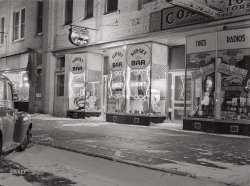
- Radio Radio: 1924
- ... near flat tront door. I wonder if the globe was lit at night with the street lights.
[We've seen these before; it's a police ... Posted by Dave - 01/10/2013 - 10:10pm -
![Radio Radio: 1924 Washington, D.C., 1924. "Interstate Commerce Commission building." Two doors down from the Jazz Age equivalent of the Apple Store. Note police call box with Bat Signal globe. Harris & Ewing Collection glass negative. View full size.
Call him FuzzyThe Ghost in the middle was probably running to escape the Mold eating the near side of the street.
ReflectionsThe base of the "Bat Signal" seems to be scratched up or dirty, but most of the globe is quite reflective. It shows us the buildings across the street (behind the camera), as well as possibly a glimpse of the photographer (or maybe just the top of the photographic equipment). If only the entire globe was shiny...
Call Box??By the handle on front, I would say this is for fire call. Police call boxes I have seen have a plainer, near flat tront door. I wonder if the globe was lit at night with the street lights.
[We've seen these before; it's a police call box. - tterrace]
The police box in your cite is a different shape. With the obvious large handle on the front and the peaked roof design I will still believe it is a alarm box for citizens to report a fire.
Tandem Fire/Police Alarm BoxI'm pretty sure the alarm box pedestal is a tandem fire and police emergency alarm box. The side facing the camera is a classic Gamewell design with the glass covered dog house door handle to gain access to the inner alarm pull handle. On the other side the roof and the door hinges are visible for an identical alarm box. I believe one box is painted red, the other blue with each respective box sending its signal to the appropriate agency. A call box with a phone normally would not have the glass covered dog house, but instead have a simple keyed door.
Back to back?Charlie B: I think you and tterrace may both be right.
San Francisco still has similar call box arrangements with back-to-back boxes for both police AND fire departments. Given the depth of the box(es) in this photo I think that'w what's going on here.
Check out the attached photo, albeit without the bracket and all-seeing eye orb.
Dueling Signal BoxesAt first I thought that the 12 years between pictures might account for the style difference, but then I came across Anton Michael's photos of modern Washington D.C. with side-by-side surviving call boxes across from Lafayette Square at Jackson Place and Pennsylvania Avenue.
The picture (used with permission) shows the back side of the fire call box with its locked door that was accessible only to the Fire Chief. Inside this half of the box was a telegraph key and receiver that could send an order for a second alarm.
Gas lamps were originally on top of the poles as seen below, but these were eventually replaced by the globes which, in turn, were replaced by the less vandal-tempting caged lights mounted on shortened poles.
A brief history of the Washington D.C. call boxes can be found here.
Call Box?? RevisitedThanks to Larmo for pointing out the obvious features of the opposite box. The site following has a history of D.C. alarm boxes. They don't show back to back, but it is interesting.
http://househistoryman.blogspot.com/2012/02/history-of-washington-dc-pol...
Reflections...of IvySplunge...I noted your unequal zoomed in photo of the globe. Might I suggest that the globe is indeed shiny and the lower part of the globe isn't scratched, but is reflecting the ivy or other plants in the lower right hand corner of the original view of the photo?
Still, the zoomed view provides a glimpse into the past that I would bet my life the original photographer never imagined we today would be focusing in and looking behind the field of view of the camera.
Southern Hemisphere@MrK - I considered that. You may be right, of course, but the reflection in question is fairly consistent from left-to-right and all the way to the bottom of the sphere, which would suggest that the ivy would run right up to the call box (which doesn't seem to be the case, given the visible sidewalk) and along a good-sized length of the street (not to mention *into* the street). Perhaps the reflection in the lower right is lightened or otherwise affected by the ivy, but to me, the rather abrupt loss of detail just south of the "equator" still suggests crusted dirt or blemishes on the globe's surface.
As for unintended reflections, they are a particular favorite of mine: see also https://www.shorpy.com/node/12105.
(The Gallery, D.C., Harris + Ewing)](https://www.shorpy.com/files/images/SHORPY_14492a.thumbnail.jpg)
- Hot and Buttered: 1930
- ...
I took my wife and son to a Japanese restaurant last night and almost everything on the grill was made with butter (with garlic of ... Posted by Dave - 06/27/2016 - 11:02am -
![Hot and Buttered: 1930 San Francisco circa 1930s. "C.W. Smith's Yum-Yum candy concession along the Great Highway at Playland-at-the-Beach." 8x10 nitrate negative attributed to George or Leo Whitney. From the Marilyn Blaisdell Collection. View full size.
Well, almost everythingWhat, no Hot Buttered cigars?
Nothing ButterThan anything hot with butter.
I took my wife and son to a Japanese restaurant last night and almost everything on the grill was made with butter (with garlic of course). Yum.
Yum(?)In addition to all the savory concoctions like buttered popcorn, candied puffed rice, walnut cream taffy, pure butterscotch, and butter taffies, they also sold -- cigars.
Quite a waist-expanding menuFor a shoppe with such narrow doors. Thank goodness for curb service.
Good Lord, the aroma!Hot buttered popcorn and butterscotch - that must’ve been intoxicating!
Brought to you by --Nice reflection of the photographer and helper. Looks like a large negative camera ... 8x10 perhaps.
[Just like it says in the caption! - Dave]
So, I'm supposed to read the caption first?
Is it possibletheir candied puffed rice is shot from guns like a more famous brand?
Butter Up!Looks like everything was buttered back then, in the same way that everything today is "sea-salt caramel" flavored! I wonder if the "candied puffed rice" was anything like Super Sugar Crisp cereal.
[Sugar Crisps are puffed wheat. Candied Puffed Rice would, I imagine, be something like Rice Krispies squares. - Dave]
Oops, I forgot that Sugar Crisp was made from wheat, but Rice Krispie treats are awesome. I'll wager that theirs were probably smothered in butter somehow!
(The Gallery, Eateries & Bars)](https://www.shorpy.com/files/images/SHORPY-994.thumbnail.jpg)
- Happy, Happy: 1937
- ... from Washington over the CBS network every Saturday night, the Church of God of Elder Solomon Lightfoot Michaux is a lively Negro ... Posted by Dave - 09/12/2011 - 7:21pm -
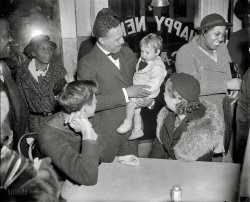
- All Nite: 1941
- ... But Also We're left to guess exactly what is hot all night, but the young man's air of quiet alertness and the saddle bags on the ... Posted by Dave - 08/13/2013 - 3:30pm -
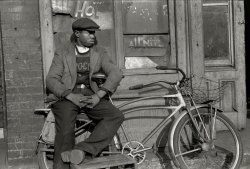
- Parched Okies: 1939
- ... ironic that about the same time, we all gathered under the night sky to watch another neighbor fly overhead in Skylab.
My last ... Posted by Dave - 02/15/2013 - 11:34am -
